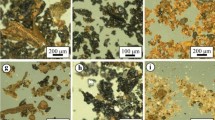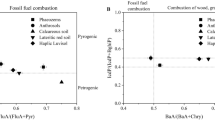Abstract
Soils are the ultimate sink for environmental pollutants like polycyclic aromatic hydrocarbons (PAHs), but the roles of major soil constituents in this process are still unclear. The fate of PAHs is governed by sorption processes which in turn affect transport, chemical and biological reactivity of these PAHs. Thus, the effects and contributions of two major soil constituents (organic matter-OM and iron oxides-IOs) on pyrene and fluorene sorption on soils were assessed by removal of both constituents. The whole soils had higher sorption than the treated OM/IOs soils. Pyrene sorption on OM-rich soils was high and nearly instantaneous, while on the IOs-rich soils, it was lower with delayed equilibrium. The IOs contributed < 25% to the sorption process while OM contributed ≥ 50%. The extent of PAHs desorption was dependent on the main constituent(s) on each soil; soils with high OM content exhibited lower desorption and high hysteresis. Hysteresis was higher for pyrene, and this was far obvious in the presence of OM; the hysteresis trend is whole > IOR > OMR soils. Though, removal of any of these soil constituents usually reduced sorption and enhanced sorbed PAHs desorption, the presence of IOs masked some PAHs sorption sites, thus its removal resulted in higher sorption. In general, this study highlights the contributions of soil OM and IOs on the sorption of pyrene and fluorene.





Similar content being viewed by others
Availability of data and materials
All relevant data have been analyzed and presented as Figures and graphs in the manuscript (some in the supporting information).
Code availability
Not applicable.
References
Abasi CY, Diagboya PNE, Dikio ED (2018) Layered double hydroxide of cobalt-zinc-aluminium intercalated with carbonate ion: preparation and Pb(II) ion removal capacity. Int J Environ Stud. https://doi.org/10.1080/00207233.2018.1517935
Adesina OA, Sonibare JA, Diagboya PN, Adeniran JA, Yusuf RO (2018) Spatiotemporal distributions of polycyclic aromatic hydrocarbons close to a typical medical waste incinerator. Environ Sci Pollut Res Int 25:274–282. https://doi.org/10.1007/s11356-017-0335-1
Ahangar AG (2010) Sorption of PAHs in the soil environment with emphasis on the role of soil organic matter: a review. World Appl Sci J 11:759–765
Amir S, Hafidi M, Merlina G, Hamdi H, Revel JC (2005) Fate of polycyclic aromatic hydrocarbons during composting of lagooning sewage sludge. Chemosphere 58:449–458. https://doi.org/10.1016/j.chemosphere.2004.09.039
An C, Huang G, Yu H, Wei J, Chen W, Li G (2010) Effect of short-chain organic acids and pH on the behaviors of pyrene in soil–water system. Chemosphere 81:1423–1429. https://doi.org/10.1016/j.chemosphere.2010.09.012
ATSDR (1995) Toxicological profile for polycyclic aromatic hydrocar-bons (PAHs) http://www.atsdr.cdc.gov/toxprofiles/tp69.pdf
Chilom G, Kohl SD, Rice JA (2005) The influence of lipids on the energetics of uptake of polycyclic aromatic hydrocarbons by natural organic matter. J Environ Qual 34:1055–1062. https://doi.org/10.2134/jeq2004.0152
Diagboya PN (2015) Sorption and desorption of selected organic and inorganic pollutants in soils collected from different agro-ecological zones of Nigeria. University of Ibadan, Ibadan
Diagboya PN, Olu-Owolabi BI, Adebowale KO (2015) Effects of time, soil organic matter, and iron oxides on the relative retention and redistribution of lead, cadmium, and copper on soils. Environ Sci Pollut Res 22:10331–10339. https://doi.org/10.1007/s11356-015-4241-0
Diagboya PN, Olu-Owolabi BI, Adebowale KO (2016) Distribution and interactions of pentachlorophenol in soils: The roles of soil iron oxides and organic matter. J Contam Hydrol 191:99–106. https://doi.org/10.1016/j.jconhyd.2016.04.005
Diagboya PN, Olu-Owolabi BI, Dikio ED, Adebowale KO (2018) Concentration-dependent and simultaneous sorption and desorption of pyrene and fluorene on major soil minerals in sub-Saharan Africa. Appl Clay Sci 153:257–264. https://doi.org/10.1016/j.clay.2017.11.037
Guo X, Luo L, Ma Y, Zhang S (2010) Sorption of polycyclic aromatic hydrocarbons on particulate organic matters. J Hazard Mater 173:130–136. https://doi.org/10.1016/j.jhazmat.2009.08.065
Hamdi H, Benzarti S, Manusadžianas L, Aoyama I, Jedidi N (2007) Bioaugmentation and biostimulation effects on PAH dissipation and soil ecotoxicity under controlled conditions. Soil Biol Biochem 39:1926–1935. https://doi.org/10.1016/j.soilbio.2007.02.008
Huang W, Peng Pa YuZ, Fu J (2003) Effects of organic matter heterogeneity on sorption and desorption of organic contaminants by soils and sediments. Appl Geochem 18:955–972. https://doi.org/10.1016/s0883-2927(02)00205-6
Koyuncu H, Yıldız N, Salgın U, Köroğlu F, Çalımlı A (2011) Adsorption of o-, m- and p-nitrophenols onto organically modified bentonites. J Hazard Mater 185:1332–1339. https://doi.org/10.1016/j.jhazmat.2010.10.050
Laor Y, Farmer WJ, Aochi Y, Strom PF (1998) Phenanthrene binding and sorption to dissolved and to mineral-associated humic acid. Water Res 32:1923–1931. https://doi.org/10.1016/S0043-1354(97)00405-3
McLeod S (1973) Studies on wet oxidation procedures for the determination of organic carbon in soils. CSIRO Division of Soils, Notes on Soil Techniques:73–79.
Mittal M, Rockne KJ (2009) Naphthalene and phenanthrene sorption to very low organic content diatomaceous earth: Modeling implications for microbial bioavailability. Chemosphere 74:1134–1144. https://doi.org/10.1016/j.chemosphere.2008.10.012
Mohubedu RP, Diagboya PNE, Abasi CY, Dikio ED, Mtunzi F (2019) Magnetic valorization of biomass and biochar of a typical plant nuisance for toxic metals contaminated water treatment. J Clean Prod 209:1016–1024. https://doi.org/10.1016/j.jclepro.2018.10.215
Mokwenye II, Diagboya PN, Oluowolabi BI, Anigbogu IO, Owamah HI (2016) Immobilization of toxic metal cations on goethite-amended soils: a remediation strategy. J Appl Sci Environ Manag 20:436–443
Olu-Owolabi BI, Diagboya PN, Adebowale KO (2014) Evaluation of pyrene sorption–desorption on tropical soils. J Environ Manage 137:1–9. https://doi.org/10.1016/j.jenvman.2014.01.048
Olu-Owolabi BI, Diagboya PN, Adebowale KO (2015) Sorption and desorption of fluorene on five tropical soils from different climes. Geoderma 239–240:179–185. https://doi.org/10.1016/j.geoderma.2014.10.012
Pérez-Novo C, Pateiro-Moure M, Osorio F, Nóvoa-Muñoz JC, López-Periago E, Arias-Estévez M (2008) Influence of organic matter removal on competitive and noncompetitive adsorption of copper and zinc in acid soils. J Colloid Interface Sci 322:33–40. https://doi.org/10.1016/j.jcis.2008.03.002
Ping L, Luo Y, Wu L, Qian W, Song J, Christie P (2006) Phenanthrene adsorption by soils treated with humic substances underdifferent pH and temperature conditions. Environ Geochem Health 28:189–195. https://doi.org/10.1007/s10653-005-9030-0
Shu Y, Li L, Zhang Q, Wu H (2010) Equilibrium, kinetics and thermodynamic studies for sorption of chlorobenzenes on CTMAB modified bentonite and kaolinite. J Hazard Mater 173:47–53. https://doi.org/10.1016/j.jhazmat.2009.08.043
Site AD (2001) Factors affecting sorption of organic compounds in natural sorbent/water systems and sorption coefficients for selected pollutants. a review. J Phys Chem Ref Data 30:187–439. https://doi.org/10.1063/1.1347984
Teixeira SCG, Ziolli RL, Marques MRC, Pérez DV (2011) Study of pyrene adsorption on two Brazilian Soils. Water Air Soil Pollut 219:297–301. https://doi.org/10.1007/s11270-010-0707-3
Vaikosen EN, Gibson LT, Davidson CM, Olu-Owolabi BI, Adebowale K, Ebeshi BU, Diagboya PN (2019) GC-MS fragmentation patterns of sprayed endosulfan and its sulphate metabolite in samples of Theobroma cacao L from a field kinetic study. Eur J Mass Spectrom 25:362–371. https://doi.org/10.1177/1469066718817690
Wang X, Li Y, Dong D (2008) Sorption of pentachlorophenol on surficial sediments: The roles of metal oxides and organic materials with co-existed copper present. Chemosphere 73:1–6. https://doi.org/10.1016/j.chemosphere.2008.06.024
Weber WJ Jr, McGinley PM, Katz LE (1992) A distributed reactivity model for sorption by soils and sediments: 1. Conceptual basis and equilibrium assessments. Environ Sci Technol 26:1955–1962
Weber WJ, Morris JC (1963) Kinetics of adsorption on carbon from solutions. J Sanit Engineering Division, Am Soc Civil Eng 89:31–60
Yang X-H, Garnier P, Wang S-Z, Bergheaud V, Huang X-F, Qiu R-L (2014) PAHs sorption and desorption on soil influenced by pine needle litter-derived dissolved organic matter. Pedosphere 24:575–584. https://doi.org/10.1016/S1002-0160(14)60043-6
Zeledón-Toruño ZC, Lao-Luque C, de las Heras FXC, Sole-Sardans M, (2007) Removal of PAHs from water using an immature coal (leonardite). Chemosphere 67:505–512. https://doi.org/10.1016/j.chemosphere.2006.09.047
Zhu D, Herbert BE, Schlautman MA, Carraway ER, Hur J (2004) Cation–π bonding. J Environ Qual 33:1322–1330. https://doi.org/10.2134/jeq2004.1322
Acknowledgements
We acknowledge the supports of the World Academy of Sciences (TWAS), Trieste Italy and the Chinese Academy of Sciences (CAS), China for the award of CAS-TWAS Postgraduate Fellowship (FR number: 3240255024) to PN Diagboya; and the Chief S.L. Edu/Chevron research grant; late Mrs. Rebecca A Okoh and Mr. VPO Okoh, Department of Estate Management, Yaba College of Technology, Lagos Nigeria, for partial funding.
Funding
All funders have been stated in the acknowledgement section.
Author information
Authors and Affiliations
Contributions
Bamidele I. Olu-Owolabi, Conceptualization; Project administration; Investigation; Methodology; Writing; Review and Editing. Paul N. Diagboya, Conceptualization; Data curation; Formal analysis; Investigation; Methodology; Project administration; Resources; Software; Validation; Writing; Review and Editing; Funding acquisition. Fanyana M. Mtunzi, Project administration; Funding acquisition. Kayode Adebowale, Project administration; Investigation.
Corresponding author
Ethics declarations
Conflicts of interests
There is no conflict of interest or competing interests.
Additional information
Publisher's Note
Springer Nature remains neutral with regard to jurisdictional claims in published maps and institutional affiliations.
Supplementary Information
Below is the link to the electronic supplementary material.
12665_2021_9530_MOESM1_ESM.pdf
Supplementary file 1. Supplementary data to this article can be found online at https://doi.org/10.1007/s12665-021-09530-9. (PDF 827 KB)
Rights and permissions
About this article
Cite this article
Diagboya, P.N., Mtunzi, F.M., Adebowale, K.O. et al. Assessment of the effects of soil organic matter and iron oxides on the individual sorption of two polycyclic aromatic hydrocarbons. Environ Earth Sci 80, 227 (2021). https://doi.org/10.1007/s12665-021-09530-9
Received:
Accepted:
Published:
DOI: https://doi.org/10.1007/s12665-021-09530-9




